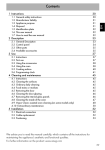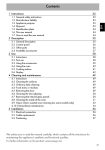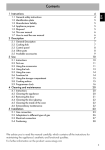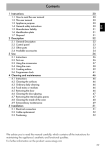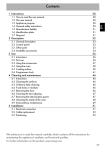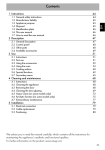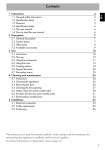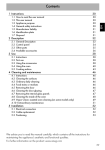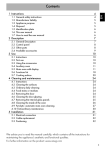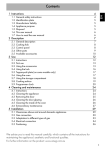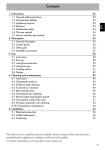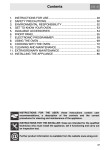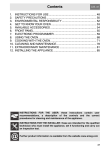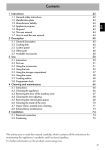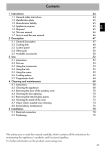Download Smeg SUK91CMX8 cooker
Transcript
Contents 1.1 1.2 1.3 1.4 1.5 1.6 1.7 General safety instructions Identification plate Manufacturer liability Appliance purpose Disposal This user manual How to read the user manual 2 Description 2.1 2.2 2.3 2.4 General Description Cooking hob Control panel Available accessories 3 Use 4 5 5 5 5 6 6 7 7 7 8 9 10 3.1 Instructions 3.2 First use 3.3 Using the accessories 3.4 Preliminary operations 3.5 Using the hob 3.6 Using the oven 3.7 Functions list 3.8 Using the storage compartment 3.9 Cooking advice 3.10 Programmer clock 4 Cleaning and maintenance 4.1 4.2 4.3 4.4 4.5 4.6 4 EN 1 Instructions Instructions Cleaning the appliance Removing the door Cleaning the door glazing Cleaning the inside of the oven Extraordinary maintenance 5 Installation 5.1 Electrical connection 5.2 Positioning 10 11 11 13 13 14 14 15 16 17 21 21 21 22 23 23 24 25 25 26 We advise you to read this manual carefully, which contains all the instructions for maintaining the appliance's aesthetic and functional qualities. For further information on the product: www.smeg.com 3 Instructions 1 Instructions 1.1 General safety instructions Risk of personal injury • During use the appliance and its accessible parts become very hot. • Never touch the heating elements during use. • Keep children under eight years of age at a safe distance if they are not constantly supervised. • Children must never play with the appliance. • This appliance may be used by children aged at least 8 and by people of reduced physical and mental capacity, or lacking in experience in the use of electrical appliances, as long they are supervised or instructed by adults who are responsible for their safety. • Never rest metallic objects such as knives, forks, spoons and lids on the appliance during use. • Switch the appliance off immediately after use. • Never try to put out a fire or flames with water: turn off the appliance and smother the flames with a fire blanket or other appropriate cover. • The appliance must never be cleaned by unsupervised children. 4 • Have qualified personnel carry out installation and assistance interventions according to the standards in force. • Do not modify this appliance. • Do not insert pointed metal objects (cutlery or utensils) into the slots in the appliance. • Do not try to repair the appliance yourself or without the intervention of a qualified technician. • If the power supply cable is damaged, contact technical support immediately and they will replace it. • Do not open the storage compartment when the oven is on and still hot. • The items inside the storage compartment could be very hot after using the oven. Risk of damaging the appliance • Do not use abrasive or corrosive detergents on glass parts (e.g. powder products, stain removers and metallic sponges). • Racks and trays have to be inserted into the side guides until they come to a complete stop. The mechanical safety locks that prevent the rack from being taken out accidentally have to face downwards and towards the oven back. • Use wooden or plastic utensils. • Do not seat on the appliance. • Do not use steam jets for cleaning the appliance. • Do not obstruct ventilation openings and heat dispersal slots. • Never leave the appliance unattended during cooking operations where fats or oils could be released. • Never leave objects on the cooking surface. • Do not use the appliance to heat rooms for any reason. • Remove any food residues or large spills from previous cooking operations from the inside of the oven. 1.3 Manufacturer liability For this appliance • Before replacing the bulb, switch off the power supply to the appliance. • Do not rest any weight or sit on the open door of the appliance. • Take care that no objects are stuck in the doors. This appliance must be disposed of separately from other waste (Directives 2002/95/EC, 2002/ 96/EC, 2003/108/EC). The appliance does not contain substances in quantities sufficient to be considered hazardous to health and the environment, in accordance with current European directives. To dispose of the appliance: • Cut the power supply cable and remove it along with the plug. 1.2 Identification plate • The identification plate bears the technical data, serial number and brand name of the appliance. Do not remove the identification plate for any reason. The manufacturer declines all liability for damage to persons or property caused by: • use of the appliance other than the one envisaged; • non-observance of the user manual provisions; • tampering with any part of the appliance; • use of non-original spare parts. 1.4 Appliance purpose • This appliance is intended for cooking food in the home environment. Every other use is considered improper. • The appliance is not designed to operate with external timers or with remote-control systems. 1.5 Disposal Power voltage Danger of electrocution • Disconnect the main power supply. • Disconnect the power cable from the electrical system. 5 EN Instructions Instructions • Consign the appliance to the appropriate selective collection centres for electrical and electronic equipment waste, or deliver it back to the retailer when purchasing an equivalent product, on a one for one basis. Our appliances are packed in nonpolluting and recyclable materials. • Consign the packing materials to the appropriate selective collection centres. Plastic packaging Danger of suffocation • Do not leave the packaging or any part of it unattended. • Do not let children play with the packaging plastic bags. 1.6 This user manual This user manual is an integral part of the appliance and must therefore be kept in its entirety and within the user's reach for the whole working life of the appliance. Read this user manual carefully before using the appliance. 1.7 How to read the user manual This user manual uses the following reading conventions: Instructions General information on this user manual, on safety and final disposal. Description Description of the appliance and its accessories. Use Information on the use of the appliance and its accessories, cooking advice. Cleaning and maintenance Information for proper cleaning and maintenance of the appliance. Installation Information for the qualified technician: installation, operation and inspection. Safety instructions Information Advice 1. Use instruction sequence. • Single use instruction. 6 Description EN 2 Description 2.1 General Description 1 Cooking hob 2 Control panel 3 Oven light 4 Seal 5 Door 6 Fan 7 Storage compartment Rack/tray support frame shelf 2.2 Cooking hob Zone Outer diameter (mm) 1 2 3 4 150 210 oval plate 195 Max. consumed power (W) * 1200 2000 2200 2000 Inner diameter (mm) 120 170 - Max. consumed power (W) * 750 1400 - 7 Description 2.3 Control panel 1 Programmer clock Other parts Useful for displaying the current time, setting programmed cooking operations and programming the minute minder timer. Shelves 2 Temperature knob This knob allows you to select the cooking temperature. Turn the knob clockwise to the required value, between the minimum and maximum setting. 3 Indicator light The indicator light comes on to indicate that the oven is heating up. It turns off as soon as it reaches the set temperature. It flashes regularly to indicate that the temperature set inside the oven is kept constant. 4 Function knob The oven's various functions are suitable for different cooking modes. After selecting the required function, set the cooking temperature using the temperature knob. 5 Cooking zone control knobs Useful for controlling the cooking zones of the hob. Push and turn the knob clockwise to adjust the operating power of the hot plate from a minimum to a maximum. 8 The appliance features shelves for positioning trays and racks at different heights. The insertion heights are indicated from the bottom upwards (see 2.1 General Description). Cooling fan The fan cools the ovens and comes into operation during cooking. The fan causes a steady outflow of air from above the door which may continue for a brief period of time even after the appliance has been turned off. Interior lighting The internal light of the ovens comes on when any function is selected. Description Rotisserie rod EN 2.4 Available accessories Some models are not provided with all accessories. Scraper Useful for cooking chicken and all foods which require uniform cooking over their entire surface. Useful for cleaning the hob. Rotisserie support Rack To be used to support the rotisserie rod. Rotisserie handle Useful for supporting containers with food during cooking. Oven tray Useful for collecting fat from foods placed on the rack above. Useful for taking the rotisserie rod out of the oven. The accessories intended to come into contact with food are made of materials that comply with the provisions of current legislation. Supplied and optional accessories can be requested to Authorised Assistance Centres. Use only original accessories supplied by the manufacturer. 9 Use 3 Use 3.1 Instructions High temperature inside the oven during use Danger of burns • Keep the oven door closed during cooking. • Protect your hands using heat resistant gloves when moving food inside the oven. • Do not touch the heating elements inside the oven. • Do not pour water directly on very hot trays. • Young children should be supervised to ensure that they do not play with the appliance. • If you need to move food or at the end of cooking, open the door 5 cm for a few seconds, let the steam come out, then open it fully. Improper use Danger of burns • Oils and fat could catch fire if overheated. Be very careful. • During use the appliance becomes hot. Care should be taken to avoid touching heating elements inside the oven. • Accessible parts will become hot when in use. To avoid burns young children should be kept away. 10 Improper use Risk of damage to surfaces • Do not cover the bottom of the oven with aluminium or tin foil sheets. • If you wish to use greaseproof paper, place it so that it will not interfere with the hot air circulation inside the oven. • Do not place pans or trays directly on the bottom of the cooking compartment. • Do not use the open door to rest pans or trays on the internal glass panel. • Do not pour water directly on very hot trays. • Cookware should be placed inside the perimeter of the hob. • All cookware must have smooth, flat bottoms. • If any liquid does boil over or spill, remove the excess from the hob. • Never place pans with bases which are not perfectly flat and smooth. • Avoid hard, solid objects falling on the surface of the hob. • In case you notice cracks or fissures, turn off the appliance immediately, disconnect the power supply and call Technical Support. • Do not use as a support surface. • Not suitable for use with aftermarket lids or covers. High temperature inside the storage compartment Danger of burns • Do not open the storage compartment when the oven is on and still hot. • The items inside the storage compartment could be very hot after using the oven. High temperature inside the oven during use Danger of fire or explosion • Do not spray any spray products near the oven. • Do not use or leave flammable materials near the oven or the storage compartment. • Do not use plastic kitchenware or containers when cooking food. • Do not put sealed tins or containers in the oven. • Do not leave the oven unattended during cooking operations where fats or oils could be released. • Remove all trays and racks which are not required during cooking. 3.2 First use 1. Remove any protective film from the outside or inside of the appliance, including accessories. 2. Remove any labels (apart from the technical data plate) from the accessories and from the cooking compartments. 3. Remove all the accessories from the appliance and clean them (see 4 Cleaning and maintenance). Heat the empty ovens at the maximum temperature to burn off any residues left by the manufacturing process. 3.3 Using the accessories Racks and trays Racks and trays have to be inserted into the side guides until they come to a complete stop. • The mechanical safety locks that prevent the rack from being taken out accidentally have to face downwards and towards the oven back. Gently insert racks and trays into the oven until they come to a stop. Clean the trays before using them for the first time to remove any residues left by the manufacturing process. 11 EN Use Use Tray rack The tray can be used two different ways: • Inside the rack (with the anti-tip stop facing upwards) to collect grease during cooking. • Resting on the rack (with the anti-tip stop facing downwards) to cook sweets, biscuits, pastries etc. 2. Screw on the handle provided so that you can handle the rod with the food on it readily. • 3. Once you have prepared the rotisserie rod, place it on the rotisserie support. Insert the rod into the hole so that it connects with the rotisserie motor. Make sure that the contoured part is placed correctly on the guide frame and remove the handle. Rotisserie rod 1. Prepare the rotisserie rod with the food using the clip forks provided. 4. To activate the rotisserie, turn the function knob to position . Grill + rotisserie cooking must never exceed 240°C and must not last more than 30 minutes. 12 5. At the end of cooking, use the rotisserie handle provided to extract the rod from the hole and remove the frame in order to take the rotisserie rod out of the oven cavity. These operations must be performed with the oven off and cold. 3.4 Preliminary operations In order to remove any moisture that could have accumulated during the manufacturing process and for the electronic circuits and control keypad to work properly: 1. Remove the protective films from the external surfaces of the appliance and accessories. 2. Remove any labels (apart from the technical data plate). 3. Place a pan full of water on each of the front cooking zones and switch them on to the maximum power setting for at least 30 minutes. 4. After 30 minutes, switch off the front cooking zones and repeat this operation for the rear cooking zones and any central cooking zone. 5. If after carrying out the above operations the controls do not work properly, it might be necessary to extend the operations until the moisture has completely evaporated. On first connection to the electrical mains, an automatic check will be carried out that will switch on all indicator lights for a few seconds. It might happen that on the displays the text appears to indicate that during factory testing the hob was switched off with residual heat active. After 5 minutes this indications deactivates automatically. 3.5 Using the hob All the appliance's control and monitoring devices are located together on the front panel. The circle next to each knob indicates the cooking position that will be put into operation. Heating within the smaller circle is adjusted pressing and turning the knob to one of the positions between minimum and maximum. To heat double zones turn the knob to the symbol or . Releasing the knob will return it to the maximum position. To adjust heating turn the knob anticlockwise to the required position. To return to heat the smaller circle only, turn the knob to 0 and then to a position between minimum and maximum. To turn off, return the knob to the 0 position. 13 EN Use Use Residual heat Improper use Danger of burns • Supervise children carefully as they cannot readily see the residual heat indicator. The cooking zones remain hot for a certain period of time even after they have been turned off. Make sure that children never touch the hob. The signal lamps located between the cooking zones come on when the temperature of one or more of the heating zones exceeds 60°C. The lamps go off upon temperature dropping to below approximately 60°C. Advice on energy-saving • The diameter of the base of the pan must correspond to the diameter of the cooking zone. • Choose a pan suitable for the quantity of food to be cooked. A large, half-empty pan leads to a waste of energy. • The bottom of the receptacles must be very thick and perfectly flat; before placing on the cooking hob, make sure that it, as well as the cooking hob itself, are perfectly clean and dry. • To avoid scratching of the cooking hob, never use cast-iron receptacles or receptacles with a rough bottom. 14 3.6 Using the oven Switching on the oven To switch on the oven: 1. Select the cooking function using the function knob. 2. Select the temperature using the temperature knob. 3.7 Functions list Eco Using the grill and the lower heating element in combination is particularly suitable for cooking on a single shelf, as it provides low energy consumption. Ideal for cooking meat, fish and vegetables. Not recommended for desserts which must rise. Static As the heat comes from above and below at the same time, this system is particularly suitable for certain types of food. Traditional cooking, also known as static cooking, is suitable for cooking just one dish at a time. Perfect for all types of roasts, bread and cakes and in any case particularly suitable for fatty meats such as goose and duck. Lower element The heat coming just from the bottom allows you to complete the cooking of foods that require a higher bottom temperature, without affecting their browning. Perfect for cakes, pies, tarts and pizzas. Small grill + rotisserie The rotisserie works in combination with the central grill heating element and allows food to be perfectly browned. Grill The heat coming from the grill element gives perfect grilling results above all for thin and medium thickness meat and in combination with the rotisserie (where fitted) gives the food an even browning at the end of cooking. Perfect for sausages, spare ribs and bacon. This function enables large quantities of food, particularly meat, to be grilled evenly. Fan with grill The air produced by the fan softens the strong heatwave generated by the grill, grilling perfectly even very thick foods. Perfect for large cuts of meat (e.g. shin of pork). Cooking with the grill and the fan with grill must never exceed a temperature of 240°C. Fan + circulaire The combination of the fan and the circulaire heating element (incorporated in the rear of the oven) allows you to cook different foods on several levels, as long as they need the same temperatures and same type of cooking. Hot air circulation ensures instant and even distribution of heat. It will be possible, for instance, to cook fish, vegetables and biscuits simultaneously (on different levels) without odours and flavours mingling. Fan assisted The operation of the fan, combined with traditional cooking, ensures consistent cooking even with complex recipes. Perfect for biscuits and cakes, even when simultaneously cooked on several levels. (For multiple-level cooking, we recommend using the 2nd and 4th shelves). 3.8 Using the storage compartment The storage compartment is at the bottom of the cooker. To open it, pull the handle towards you. It can be used to store cookware or metallic objects necessary when using the appliance. 15 EN Use Use 3.9 Cooking advice General advice • Use a fan assisted function to achieve consistent cooking at several levels. • It is not possible to shorten cooking times by increasing the temperature (the food could be overcooked on the outside and undercooked on the inside). Advice for cooking meat • Cooking times vary according to the thickness and quality of the food and to consumer taste. • Use a meat thermometer when roasting meat, or simply press on the roast with a spoon. If it is hard, it is ready; if not, it needs another few minutes cooking. Advice for cooking with the Grill and the Fan with grill • Meat can be grilled even when it is put into the cold oven or into the preheated oven if you wish to change the effect of the cooking. • With the Fan with grill function, we recommend that you preheat the oven before grilling. • We recommend placing the food at the centre of the rack. • With the Grill function, we recommend that you turn the temperature knob to the maximum value near the symbol to optimise cooking. • Foods should be seasoned before cooking. Foods should also be coated with oil or melted butter before cooking. • Use the oven tray on the first bottom shelf to collect fluids produced by grilling. 16 • Grilling processes should never last more than 60 minutes. Advice for cooking desserts/pastries and biscuits • Use dark metal moulds: they help to absorb the heat better. • The temperature and the cooking time depend on the quality and consistency of the dough. • To check whether the dessert is cooked right through: at the end of the cooking time, put a toothpick into the highest point of the dessert. If the dough does not stick to the toothpick, the dessert is cooked. • If the dessert collapses when it comes out of the oven, on the next occasion reduce the set temperature by about 10°C, selecting a longer cooking time if necessary. • While cooking desserts or vegetables, excessive condensation may form on the glass. In order to avoid this, open the door very carefully a couple of times while cooking. Advice for defrosting and proving • Place frozen foods without their packaging in a lidless container on the first shelf of the oven. • Avoid overlapping the food. • To defrost meat, use the rack placed on the second level and a tray on the first level. In this way, the liquid from the defrosting food drains away from the food. • The most delicate parts can be covered with aluminium foil. • For successful proving, a container of water should be placed in the bottom of the oven. Use 3.10 Programmer clock Setting the time EN To save energy • Stop cooking a few minutes before the time normally used. Cooking will continue for the remaining minutes with the heat which has accumulated inside the oven. • Reduce any opening of the door to a minimum to avoid heat dispersal. • Keep the inside of the appliance clean at all times. If the time is not set, the oven will not switch on. On the first use, or after a power failure, the digits will be flashing on the appliance's display. 1. Press the and keys at the same time. The dot between the hours and the minutes flashes. 2. The time can be set using or . Keep the key pressed in to increase or decrease rapidly. 3. Press the key or wait 5 seconds. The dot between the hours and the minutes stops flashing. 4. The symbol on the display indicates that the appliance is ready to start cooking. 1 Minute minder timer key 2 Cooking duration key 3 End of cooking key 4 Value decrease key 5 Value increase key Please make sure the programmer clock shows the cooking duration symbol , otherwise the oven will not switch on. Press keys and at the same time to reset the programmer clock. 17 Use Timed cooking Timed cooking is the function which allows a cooking operation to be started and then ended after a specific length of time set by the user. 1. After selecting a cooking function and temperature, press key . The display will shows the digits and the symbol displayed between the hours and the minutes. 2. Use the or key to set the required minutes. 3. Wait approx. 5 seconds without pressing any key in order for the function to activate. The current time and the symbols and will appear on the display. 4. At the end of cooking the heating elements will be deactivated. On the display, symbol turns off, symbol flashes and the buzzer sounds. 5. To turn off the buzzer just press any key of the programmer clock. 6. Press keys and at the same time to reset the programmer clock. It is not possible to set a cooking time of more than 10 hours. After the setting, to display the cooking time left press the key. To reset the set program, press keys and at the same time and switch off the oven manually. 18 Programmed cooking Programmed cooking is the function which allows a cooking operation to be started at a set time and then ended after a specific length of time set by the user. 1. Set the cooking time as described in the previous point “Timed cooking”. 2. Press . The sum of the current time plus the pre-set cooking duration will appear on the display. 3. Use the or key to set the required minutes. 4. Wait approx. 5 seconds without pressing any key in order for the function to activate. The current time and the symbols and will appear on the display. 5. At the end of cooking the heating elements will be deactivated. On the display, symbol turns off, symbol flashes and the buzzer sounds. 6. To turn off the buzzer just press any key of the programmer clock. 7. Press keys and at the same time to reset the programmer clock. After the setting, to display the cooking time left press the key. To display the end of cooking time, press the key. Minute minder timer The minute minder timer does not stop the cooking operation but rather informs the user when the set time has run out. The minute minder timer can be activated at any time. 1. Press . The display shows the digits and the indicator light flashing between the hours and the minutes. 2. Use the or key to set the required minutes. 3. Wait approx. 5 seconds without pressing any key to finish setting the minute minder. The current time and the symbols and Adjusting the buzzer volume The buzzer volume can be set to 3 different levels. When the buzzer is in operation, press to change the setting. Deleting the set data Press keys and at the same time to reset the programs set. Then switch off the oven manually if cooking is in progress. appear on the display. It is not possible to set a cooking time of more than 24 hours. After the minute minder timer has been programmed, the display will go back to showing the current time; to display the remaining time, press . 19 EN Use Use Cooking information table Temperature Static Static Runner position from the bottom 1 1 220 - 230 220 - 230 45 - 50 45 - 50 2 2 1.5 1 1.5 3 2-3 1.2 Turbo Turbo Fan with grill Turbo Circulaire Turbo Turbo Turbo 2 2 4 2 2 2 2 2 180 - 190 180 - 190 240 200 180 - 190 180 - 190 180 - 190 180 - 190 90 - 100 70 - 80 15 40 - 45 70 - 80 110 - 120 170 - 180 65 - 70 Pork chops Spare ribs Bacon Pork fillet Beef fillet 1.5 1.5 0.7 1.5 1 Fan with grill Fan with grill Grill Fan with grill Grill 4 4 5 4 5 240 240 240 240 240 Salmon trout Monkfish Turbot 1.2 1.5 1.5 Turbo Turbo Turbo 2 2 2 150 - 160 160 160 35 - 40 60 - 65 45 - 50 1 1 1 Turbo Circulaire Turbo 2 2 2 260 190 - 200 180 - 190 8-9 25 - 30 20 - 25 1 1 1 1 1.2 1.2 1 1 0.6 Circulaire Circulaire Circulaire Turbo Circulaire Turbo Circulaire Turbo Circulaire 2 2 2 2 2 2 2 2 2 160 160 160 - 170 160 160 180 150 - 160 160 160 55 - 60 35 - 40 55 - 60 20 - 25 55 - 60 80 - 90 55 - 60 55 - 60 30 - 35 Weight (Kg) Function Lasagne Pasta bake 3-4 3-4 Roast veal Pork Sausages Roast beef Roast rabbit Turkey breast Roast pork neck Roast chicken Food (°C) Time (minutes) 1st surface 2nd surface Pizza Bread Focaccia Bundt cake Jam tart Ricotta cake Jam tarts Paradise cake Profiteroles Sponge cake Rice pudding Brioches 15 10 7 10 10 5 10 8 5 7 The times indicated in the table do not include preheating times and are provided as a guide only. 20 4 Cleaning and maintenance 4.1 Instructions Improper use Risk of damage to surfaces • Do not use steam jets for cleaning the appliance. • Do not use cleaning products containing chlorine, ammonia or bleach on steel parts or parts with metallic finishes on the surface (e.g. anodizing, nickel- or chromium-plating). • Do not use abrasive or corrosive detergents on glass parts (e.g. powder products, stain removers and metallic sponges). • Do not use rough or abrasive materials or sharp metal scrapers. • Do not wash the removable components such as the hob pan stands, flame-spreader crowns and burner caps in a dishwasher. 4.2 Cleaning the appliance To keep the oven surfaces in good condition, they should be cleaned regularly after use. Let them cool first. Ordinary daily cleaning Always use only specific products that do not contain abrasives or chlorine-based acids. Dirt which may have fallen on the hob while cleaning lettuce or potatoes can scratch the hob when moving pans. Consequently, remove any dirt from the cooking surface immediately. Pour the product onto a damp cloth and wipe the surface, rinse thoroughly and dry with a soft cloth or a microfibre cloth. Food stains or residues Do not use metallic sponges or sharp scrapers as they will damage the surfaces. Use ordinary non-abrasive products with the aid of wooden or plastic utensils if necessary. Rinse thoroughly and dry with a soft cloth or a microfibre cloth. Do not allow residues of sugary foods (such as jam) to set inside the oven. If left to set for too long, they might damage the enamel lining of the oven. Cleaning the glass ceramic hob Smudges from aluminium-based pans can be easily cleaned off with a cloth dampened in vinegar. After cooking, remove any burnt residues with the provided scraper; rinse with water and dry thoroughly with a clean cloth. Regular use of the scraper considerably reduces the need for chemical detergents for the daily cleaning of the hob. Changes in colour do not affect the operation and stability of the glass. These are not alterations to the material of the hob but just residues which have not been removed and have then carbonised. Shiny surfaces can form due to the bases of pans, especially aluminium ones, rubbing on the surface, and due to the use of unsuitable detergents. They are difficult to remove using conventional cleaning products. It may be necessary to repeat the cleaning process several times. Using aggressive detergents, or friction with the base of pans, can wear away the decoration on the hob over time and contribute to the formation of stains. 21 EN Cleaning and maintenance Cleaning and maintenance Weekly cleaning 4.3 Removing the door Clean and maintain the hob once a week using an ordinary glass ceramic cleaning product. Always follow the manufacturer's instructions. Silicon in these products creates a protective, water-repellent membrane which also resists dirt. All marks stay on the membrane and can therefore be easily removed. After cleaning, dry the surface with a clean cloth. Make sure that there is no detergent left on the cooking surface as it might undergo an aggressive reaction when heated up and could modify the structure of the cooking surface. For easier cleaning, the door can be removed and placed on a canvas. To remove the door proceed as follows: 1. Open the door completely and insert two pins into the holes on the hinges indicated in the figure. 2. Grasp the door on both sides with both hands, lift it forming an angle of around 30° and remove it. 22 3. To reassemble the door, put the hinges in the relevant slots in the oven, making sure that grooved sections A are resting completely in the slots. Lower the door and once it is in place remove the pins from the holes in the hinges. 4.5 Cleaning the inside of the oven For the best oven upkeep, clean it regularly after having allowed it to cool. Take out all removable parts. 4.4 Cleaning the door glazing The glass in the door should always be kept thoroughly clean. Use absorbent kitchen roll. In case of stubborn dirt, wash with a damp sponge and an ordinary detergent. We recommend the use of cleaning products distributed by the manufacturer. Clean the oven racks with warm water and non-abrasive detergent. Carefully rinse and dry the damp parts. The oven should be operated at the maximum temperature for about 15-20 minutes after the use of specific products, to burn off the residues left inside the oven. For easier cleaning, remove the door. 23 EN Cleaning and maintenance Cleaning and maintenance 4.6 Extraordinary maintenance Live parts Danger of electrocution • Ensure the appliance is switched off before replacing the lamp to avoid the possibility of electric shock. Removing the seal To permit thorough cleaning of the oven, the door seal can be removed. There are hooks on all four sides to attach it to the edge of the oven. Pull the edges of the seal outwards to detach the hooks. Replacing the internal light bulb Remove the bulb protector A by turning it anticlockwise and replace bulb B with a similar one. Re-fit bulb protector A. To keep the seals clean, use a non-abrasive sponge and lukewarm water. Seals should be soft and elastic. 24 Installation 5.1 Electrical connection The appliance can work in the following modes: • 220-240 V 1N~ EN 5 Installation Power voltage Danger of electrocution • Have the electrical connection performed by authorised technical personnel. • Use personal protective equipment. • The appliance must be connected to earth in compliance with electrical system safety standards. • Disconnect the main power supply. • Do not pull the cable to remove the plug. • Use cables withstanding a temperature of at least 90°C. • The tightening torque of the screws of the terminal supply wires must be 1.5 - 2 Nm. General information Check the grid characteristics against the data indicated on the plate. The identification plate bearing the technical data, serial number and brand name is visibly positioned on the appliance. Do not remove this plate for any reason. Perform the ground connection using a wire that is 20 mm longer than the other wires. Use a 3 x 6 mm² three-core cable. • 380-415 V 2N~ Use a 4 x 4 mm² four-core cable. • 380-415 V 3N~ Use a 5 x 2.5 mm² five-core cable. The values indicated above refer to the cross-section of the internal conductor. The aforementioned power cables are sized taking into account the coincidence factor (in compliance with standard EN 60335-2-6). 25 Installation Fixed connection Fit the power line with an omnipolar circuit breaker in compliance with installation regulations. The circuit breaker should be located near the appliance and in an easily reachable position. Connection with plug and socket Make sure that the plug and socket are of the same type. Avoid using adapters and shunts as these could cause overheating and a risk of burns. 5.2 Positioning Heavy appliance Danger of crush injuries • Place the appliance into the piece of furniture with the aid of a second person. Pressure on the open door Risk of damages to the appliance • When positioning the appliance during installation, do not use the door handle to lift up or move this appliance. • Never use the oven door to lever the appliance into place when fitting. • Avoid exerting too much pressure on the oven door when open. Heat production during appliance operation Risk of fire • Veneers, adhesives or plastic coatings on adjacent furniture should be temperature-resistant (no less than 90°C). General information This appliance may be installed next to walls, one of which must be higher than the hob side of the appliance, as shown in figures A and C relative to the installation classes. Any wall units positioned above the worktop must be at a minimum distance of at least 750 mm. If a hood is installed above the hob, refer to the hood instruction manual to ensure the correct clearance is left. 26 Installation EN Depending on the type of installation, this appliance belongs to classes: C - Class 2 subclass 1 A - Class 1 (Free-standing appliance) (Built-in appliance) The appliance must be installed by a qualified technician and according to the regulations in force. If the appliance is installed on a raised platform, secure it using suitable fastening systems. DO NOT MODIFY THIS APPLIANCE. B - Class 2 subclass 1 (Built-in appliance) 27 Installation Assembling the skirt The skirt provided is an integral part of the product; it must be fastened to the appliance prior to installation. The skirt must always be positioned and secured correctly on the appliance. 1. Unscrew the 2 nuts (B) on the back of the hob. 2. Position the skirt above the hob, taking care to align the pins (C ) with the holes (D). 3. Secure the skirt to the hob by tightening screws (A). Positioning and levelling the appliance Heavy appliance Risk of damages to the appliance • Insert the front feet first and then the rear ones. After making the electrical and/or gas connections, level the appliance on the floor by means of its four adjustable feet. The appliance must be properly levelled to ensure better stability. Screw or unscrew the bottom part of the foot until the appliance is stable and level on the floor. 28




























